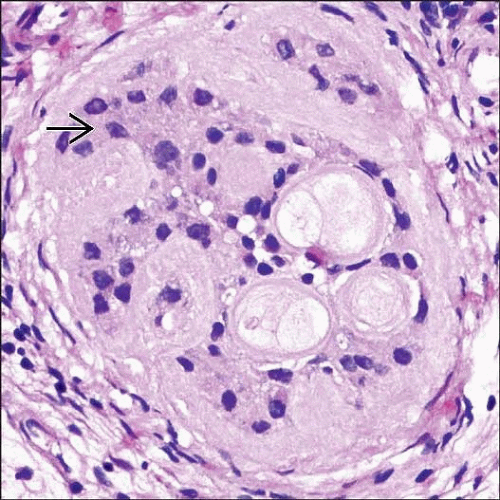Testicular Sertoli Cell Neoplasms
Gladell P. Paner, MD
Key Facts
Terminology
Group of testicular neoplasms with Sertoli cell differentiation linked to syndromes such as Carney complex and Peutz-Jeghers syndrome
Most ILCHSCN described in Peutz-Jeghers syndrome
Most SCT and ˜60% of LCCSCT are sporadic
Clinical Issues
ILCHSCN: Benign course, but a subset may transform to invasive SCT or LCCSCT
SCT: Majority benign; ˜10% are malignant and may metastasize
LCCSCT: Majority benign; ˜20% malignant
Microscopic Pathology
ILCHSCN: Seminiferous tubules with thickened basement membrane
Expanded by large Sertoli cells with pale to eosinophilic cytoplasm and globular, eosinophilic basement membrane deposits
SCT: Hallmark tubular growth of regular cuboidal or columnar cells with pale to pink cytoplasm that may be vacuolated
LCCSCT: Large polygonal cells with abundant eosinophilic ground-glass cytoplasm associated with hallmark irregular or psammomatous calcifications
Ancillary Tests
Inhibin (+), PLAP and OCT3/OCT4 (-)
Top Differential Diagnoses
Leydig cell tumor
Granulosa cell tumor
Adenomatoid tumor
TERMINOLOGY
Definitions
Group of testicular neoplasms with Sertoli cell differentiation linked to syndromes such as Carney complex and Peutz-Jeghers syndrome
Intratubular large cell hyalinizing Sertoli cell neoplasia (ILCHSCN): Intraseminiferous tubular neoplasia of large Sertoli cells admixed with globular basement membrane deposits
Subset may progress to invasive Sertoli cell tumor (SCT) or large cell calcifying SCT (LCCSCT)
SCT: Sex cord-stromal tumor exhibiting variable patterns and hallmark tubular growth
LCCSCT: Variant of SCT composed of large epithelioid cells with abundant eosinophilic cytoplasm and peculiar calcifications
Most ILCHSCN described in Peutz-Jeghers syndrome
Vast majority of SCT and ˜60% of LCCSCT encountered as sporadic tumors
˜40% of LCCSCT linked to syndromes
ETIOLOGY/PATHOGENESIS
Syndromes/Familial Sertoli Cell Neoplasms
Peutz-Jeghers syndrome
Mainly caused by mutations in STK11/LKB1
Autosomal dominant disorder characterized by multiple hamartomatous polyps and mucocutaneous pigmentations with higher risk for multiple visceral organ cancers (lifetime risk of 37-93%)
ILCHSCN, LCCSCT, and SCT described in patients with this syndrome
Carney complex
Autosomal dominant multiple neoplasia syndrome
Caused by mutations in PRKAR1A (45-80%)
LCCSCT is a component of this complex
CLINICAL ISSUES
Epidemiology
Incidence
SCT and LCCSCT are rare tumors
Age
SCT: ˜30% occur in 1st decade of life
LCCSCT: Mostly prepubertal boys to young adult men; mean: ˜30 years
ILCHSCN: < 15 years of age; mean: 6.8 years
Presentation
ILCHSCN may exhibit testicular enlargement but no discrete mass
SCT and LCCSCT may present as painless testicular mass or enlargement
LCCSCT has higher chance for bilaterality, particularly in Carney syndrome
Hormone-related symptoms, such as gynecomastia (most common), precocious puberty, or advanced skeletal maturation
Discovery of testicular tumors from other syndromic manifestations
Peutz-Jeghers syndrome
Mucocutaneous pigmentations, bowel obstruction, or intussusception from multiple gastrointestinal polyps
Carney complex
Spotty pigmentation of skin, cardiac or cutaneous myxomas, endocrinopathy, schwannomas
Stay updated, free articles. Join our Telegram channel

Full access? Get Clinical Tree





